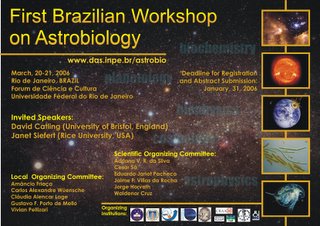
For over 2 weeks I have been dealing with finishing two papers and organizing this Astrobiology workshop. The objective of the I Brazilian Workshop on Astrobiology (BWA) is to gather, for the first time in Brazil, professional scientists and graduate students from different fields that have been working or are interested in starting a career in one of the various topics related to Astrobiology, in a formal and academic environment.
The increasing number of papers in this area in the last few years is noticeable, coming mainly from Astronomy, Biology, Chemistry and Geology fields. Presently in Brazil there are astronomers searching for exoplanets, trying to understand the formation of planetary discs and, along with chemists, studying the chemistry of interstellar medium, particularly searching for organic compounds. Biologists have focused on extremophiles, studying their survival conditions and evolution in environements under extreme conditions (high temperature, pressure, salinity and pH). Geologists have worked in the investigation of atmospheric and geologic records of young Earth.
The I BWA is intended as an environment for scientists and graduate students interested in this multidisciplinary field to exchange ideas, results and perspectives for the development of the field in Brazil, with poster sessions, review talks and oral communications. The discussion sessions at the end of morning and afternoon talks will offer a good opportunity to exchange specific knowledge and expertise among the different fields represented in the workshop.
Go visit the web page!!!
Right now, finishing the IAU poster - "Can the Local Supercluster explain the low CMB multipoles?". The idea is that the low quadrupole observed in the CMB power spectrum since the COBE measurements, and confirmed by many other experiments in the late 90s and the WMAP data, might be due to the SZ effect in the direction of the Virgo cluster. The strong effect may remove the CMB photons from that area, distorting the low order multipoles and introducing an alignment mainly noted in the quadrupole and octupole.
We made a statistical test to verify if the alignment and the low intensity of the quadrupole could happen by chance. In short, the chance that this alignment is caused by a SZ intensity as we propose is larger than 1 sigma. On the other hand, the chance that the effect is purely caused by the CMB data as measured by WMAP is ruled out by over 2.5 sigma.
I gotta go back to finish the poster.
Soundtrack: Bluesology (Modern Jazz Quartet)
Oi Alex,
ResponderExcluirMuito bom saber que você também tem um blog!
Bom saber que seus interesses nao foram embora com a mudanca para o CTA.
No dia em que os meus interesses em ciência forem embora, significará que eu estarei morta, mortinha.
A ida para o CTA significou a única oportunidade de emprego - na ocasião - dadas as condições de contorno.
Abraços,
Chris